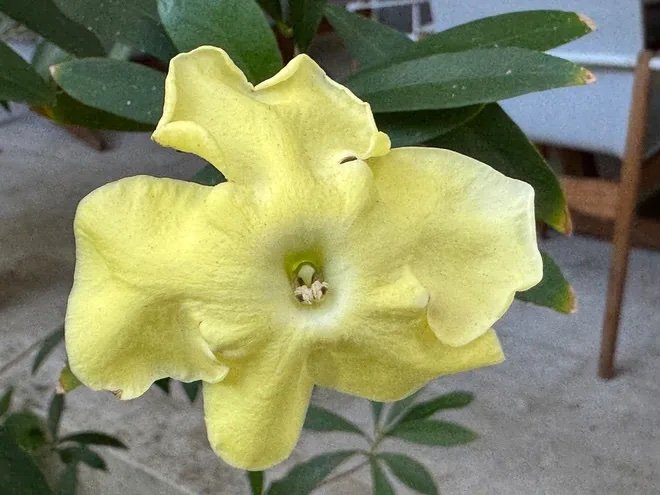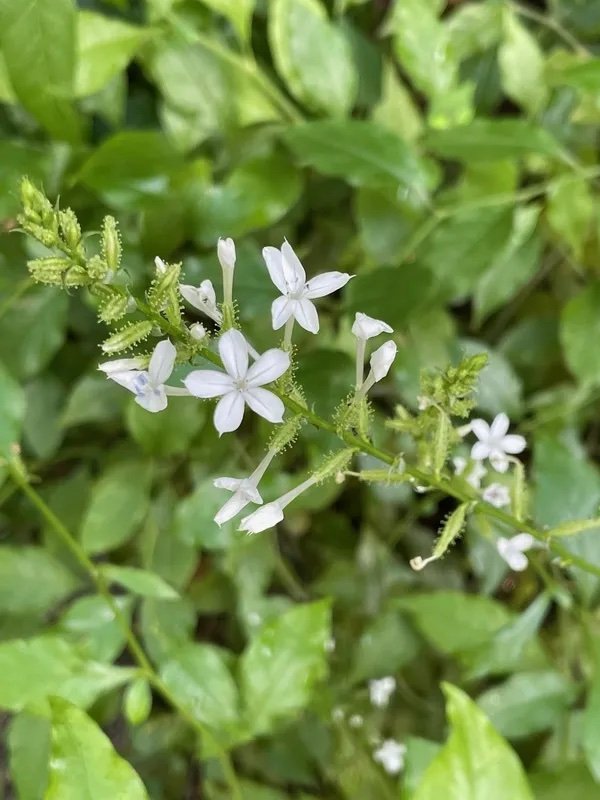Bright flowers, lush foliage, heavenly fragrance: It's a perfect time to be in the garden
The deep reddish pink flowers of Jatropha integerrima add a blast of color to any green area, such as hedges.
January 11, 2024
With the rest of the East Coast under a winter storm watch, it’s great to be in Florida, where we are surrounded by bright flowers and lush foliage. Despite the less-than-perfect weather we’ve had recently, or maybe because of it, my garden is full of color and fragrance.
In my book, fragrance is one of the most important elements of any garden, adding a whole new dimension to the beauty of a landscape. With the right plants, you can have the intangible joy of glorious scents wafting from your garden for months at a time.
When my Brunfelsia americana is in bloom, I just want to stop everything and have a party. It’s a fragrance you can’t really describe: a delicious mixture of cloves and cinnamon, reminiscent of gardenia but not as sweet or overpowering; it calls you into the garden to discover its source. And the beautiful flowers provide nectar for numerous pollinators, butterflies and hummingbirds with their long tubular blooms.
Brunfelsia americana has a fragrance that smells of cloves and cinnamon, and it brings bright yellow petals to the garden when it is in bloom.
Brunfelsia is native to the Caribbean and South America, but is Florida-friendly, and the fragrance is well worth adding it to your gardens. Clusters of 2-inch long flowers open white and turn a creamy yellow with age; the fragrance is light during the day, becoming heady and truly amazing at dusk.
Of the many species of Brunfelsia, B. americana is by far the most fragrant. The upright vase shape and glossy green foliage make this a wonderful ornamental shrub growing to about 5 inches, though it can be pruned to keep it smaller. It prefers light shade but is not particular as to soil or moisture requirements once established.
Another species, Brunfelsia gigantiflora, with larger white flowers up to 5 inches across and thicker foliage grows to 10 inches. The fragrance is not as intense as B. americana, but this is still a wonderful addition to any garden.
Interestingly, Brunfelsia grandiflora, commonly known as yesterday, today, and tomorrow, is the species of this genus most often seen in Palm Beach gardens. This has very little fragrance but is loved for the beautiful flowers that open white, turning lavender and then purple over a three-day period, with all three colors appearing on the plant at the same time. All the Brunfelsias are members of the alkaloid-rich Solanaceae (nightshade) family, so are poisonous to dogs and cats if ingested, something to consider if you have plant-eating pets.
Yellow thryallis and pink Panama rose add bursts of color to hedges in Florida yards.
Another wonderfully fragrant plant that is about to bloom is sweet almond bush (Aloysia virgata), with tall spikes of bright white flowers that smell like heaven. This must have full sun to thrive, but if you can plant it near a gate or entryway, it will delight you every time you enter your garden, while neighbors and friends will knock on your door to find out what is that fabulous aroma.
This will grow to 10 or 12 feet with long, somewhat brittle branches and rough foliage; pruning will keep a more compact, dense shape. The flower spikes are magnets for butterflies, bees and other pollinators; the butterflies include hairstreaks, blues and the rare atalas, who flock to the flowers for their nectar. Dried flowers can be added to potpourri or simply left in a dish for fragrance.
Maypop (Passiflora incarnata) is Florida’s most ornate native passionflower with wonderfully fragrant, wildly ostentatious blooms. This herbaceous perennial vine can be grown on a fence or a trellis or up the side of a tree, with stems up to 20 feet or more.
It is the larval host for Gulf and variegated fritillaries, Julias and zebra longwing and heliconian butterflies. Its cousin, the corkystem passionflower (Passiflora suberosa), is more common but with a far less extravagant flower and no fragrance. But both species will provide you with an unending supply of butterflies, and the zebras are such fun for your kids and grandkids to chase around the garden.
Plants such as red firespike are known to draw pollinators and butterflies. Ruby-throated hummingbirds are especially partial to red firespike.
Moving on to the color aspect of the garden — there is so much in bloom right now! Yellow thryallis and pink Panama rose (Rondeletia leucophylla) make a wonderful hedge on the north side, flanked by tall brilliant crimson spears of red firespike (Odontonema cuspidatum) and deep reddish pink flowers of perergrina (Jatropha integerrima).
All of these are pollinator and butterfly attractors, with ruby-throated hummingbirds being particularly partial to the jatropha and red firespike. These are all musts if you either have or aspire to having a butterfly garden.
Beside the firespike, beautiful yellow blossoms of necklace pod (Sophora tomentosa) are just starting to open, with their elegant spikes of pea-like flowers. This is another hummingbird attractor and is great for coastal areas, as it is drought- and salt-tolerant.
Tecoma stans, also known as yellow elder, is the national flower of the Bahamas and the official flower of the U.S. Virgin Islands. It can withstand heavy winds and usually remains intact after storms.
On the east side, Tecoma stans, or yellow elder, has been blooming continuously for months. This is the national flower of the Bahamas and the official flower of the U.S. Virgin Islands, and for good reason. The beautiful bright yellow flowers can withstand heavy winds; I am always amazed to see it still covered with blooms after a severe storm.
It can reach a height of 16 feet but can also be pruned to a smaller size if you can bear to cut off the buds, which always seem to be appearing. Skippers and other butterflies love the nectar, as do hummingbirds and other nectar seeking birds. This is not a true native but has naturalized in Florida, so it is easy to find. It also makes a wonderful screen, alone or mixed with coco plum or firebush. The common name elder is due to the similarity of its foliage to the elderberry bush.
The white flowers of native plumbago are known to extend their stems into the foliage of neighboring nonblooming plants, creating the illusion of flowers on the wrong plant.
The delicate white flowers of native plumbago (Plumbago zeylanica) love to extend their long stems into the foliage of neighboring non-blooming plants creating a fun illusion of flowers on the wrong plant — ideal to fool inquiring visitors.
Blue plumbago (P. auriculata) is another favorite with wonderful deep blue flowers year-round. This is the larval host of the small cassius blue butterfly, whose dorsal (upper side) wings are the exact color match for the plumbago flowers. Red and pink salvias, blue porterweed, violet twinflower, and yellow coreopsis are also blooming right now, along with all the orchids we’ve added to the trees.
It’s always colorful, often fragrant, and never dull in the garden!
None of these plants have ever seen a chemical pesticide or herbicide and they are all thriving – just say NO to Chemicals in your gardens – you’ll be rewarded with birds and butterflies and the wonderful fragrances of nature.
-Kim Frisbie
Original article on the Palm Beach Daily News is HERE.






